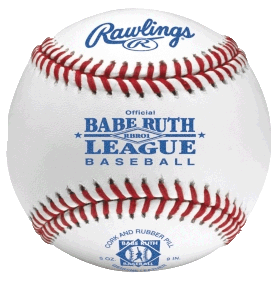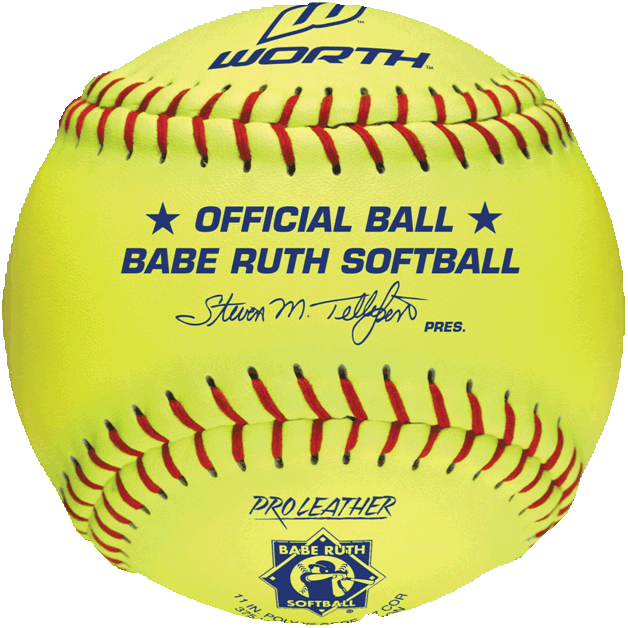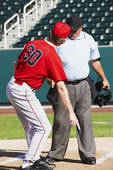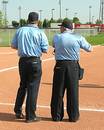|
Tournament Sites Must Use Members of the National Umpires Association
Per Babe Rule League Rule 11.05, Paragraph 2, all umpires who work District, State and Regional Tournaments, as well as the World Series, are required to be a member of the Babe Ruth League National Umpire Association.
Official Playing Rules
All Babe Ruth Baseball(including Cal Ripken Baseball) and Babe Ruth Softball games must be played in accordance with the Official Baseball Rules and the Official Babe Ruth Softball Rules, respectively, with a few exceptions that are listed in the rules and regulations. Be certain to use the Official Baseball Rules and the Official Babe Ruth Softball Rules and not those of the National High School Athletic Associations, or any other group, as there are major differences between the sets of rules.
Official Tournament Ball
Baseball - Rawlings is the only official Tournament Baseball to be used for all District, State, Regional and World Series competition. Regional and World Series competition.
Softball - Worth is the Official Tournament Softball and the only brand to be used for  all Softball District, State, Regional and World Series competition. all Softball District, State, Regional and World Series competition.
Check List for Tournament Time
- Make sure you have the proper clothing and equipment. Press it, buff it, shine it. Look the part!
- Attend all pre-tournament meetings. There will be discussions on the rules and ground rules.
- Reacquaint yourself with the rulebook. Read it over and over. Review such rules as obstruction, interference, infield fly and appeal plays.
- You represent the game, so act professionally.
- Be at the game early, not just on time.
- Have a pre-game meeting with your partners.
- Ignore the fans. The tournament games will be well-attended. Yes you will be booed and worse.
- Ump Big! Sell each and every call.
- Do not tighten up your strike zone. The games mean too much.
- Relax. Let the game come to you. Allow players to make mistakes, and then react to them.
- Above all, use your head and experience. You will be surprised how smooth your games will go.
Handling Coaches and Ejections
 There are many different views on how to handle coaches and ejections. Anejection is an unfortunate consequence of any sport. It implies failure---on theumpire's part as well as on the part of the ejected player or manager. Nobodywins as a result of an ejection. Therefore the official should try to prevent suchaction and use it only as a last resort. This may require "thickening" the skin a bit to allow an athlete to vent some of the frustration that results from either atruly booted call, or the mere perception by the athlete that a call was in factbooted. In either case the official should not take it personally when the athletebegins to "go off." Try to remember that the athlete isn't really reacting to the umpire in a personal way. Rather he is reacting to the call, and even to the game itself. We all know that emotions run high during the heat of battle. So what an athlete says or does should sometimes be forgiven. There are many different views on how to handle coaches and ejections. Anejection is an unfortunate consequence of any sport. It implies failure---on theumpire's part as well as on the part of the ejected player or manager. Nobodywins as a result of an ejection. Therefore the official should try to prevent suchaction and use it only as a last resort. This may require "thickening" the skin a bit to allow an athlete to vent some of the frustration that results from either atruly booted call, or the mere perception by the athlete that a call was in factbooted. In either case the official should not take it personally when the athletebegins to "go off." Try to remember that the athlete isn't really reacting to the umpire in a personal way. Rather he is reacting to the call, and even to the game itself. We all know that emotions run high during the heat of battle. So what an athlete says or does should sometimes be forgiven.
If you are able to avoid ejecting players, or are able to eject them only when it'sabsolutely necessary and to do so in a professional and "unemotional" manner,you will obtain the ultimate compliment---THE RESPECT OF THE PLAYERS. Intime players and managers alike will come to realize that you are an umpire with integrity. They will come to realize that you take your job seriously, not personally, and that you are an honest person who will let them play the game with a minimum of intervention on your part. In other words, they will come to trust you. And along with that trust will come the kind of respect that will cause them to back off when you hold your hand in the air to indicate you've had enough when things start getting out of control.
If an ejection is unavoidable, try to handle it in a professional manner. The best approach is to call the coach over to inform him that his player is going home. If the offending player makes it nearly impossible to get the coach over, then simply inform him that his day is over. Then ignore him and walk away until the coach can get to you. In the meantime, take your pencil and lineup card out of your pocket in preparation for doing the necessary paper work. When his coach does come out, inform him of why his player was ejected, get the replacement's name, and don't start the game until the ejected player has left the playing field.
The following is a general guideline to be considered when deciding whether to eject a player, coach, manager or other person from the game:
- Use of profanity or vulgar personal insults directed at an umpire.
- Physical contact with an umpire.
- Refusal to stop arguing and further delaying the game after the umpire has provided a player or coach adequate opportunity to make a point. The umpire shall warn the player or coach that he has been heard and that he should return to his position or be ejected.
- If a player, coach or manager leaves his position to argue a call, he should be warned to immediately return or be ejected.
- Use of histrionic gestures (i.e., jumping up and down, violently waving arms or demonstrations) while arguing with an umpire or stepping out of the dugout, throwing anything out of the dugout, and making gestures toward an umpire, are grounds for ejection.
- Actions by team personnel specifically intended to ridicule an umpire.
- Throwing equipment in disgust over an umpire’s call, if the umpire deems the action severe.
- Any player, manager or coach who fails to comply with an order from an umpire to do or refrain from doing anything that affects administering the rules and regulations. Example, failure to stay within the lines of the batter’s box after a warning.
While standards here may justify an ejection, Official Baseball Rule 9.01(d) grants umpire discretion to eject any participant for objecting to decisions or for unsportsmanlike conduct or language.
Between Innings
The suggested position for base umpires between innings is a few steps onto the outfield grass, approximately midway between first and second (or between second and third). The suggested position for the plate umpire between innings is on the first or third base foul line, one-fourth to  one-half the way up the line from home plate. The idea in each of these positions is for the umpire to be in a “neutral” position between innings, one which does not prompt conversations and confrontations with players, coaches or managers. If the plate umpire is having trouble during a particular inning, he is to go to the opposite foul line from that team’s dugout between innings. The same holds true for base umpires. If trouble can be expected from a team coming onto the field to take their position between innings, the base umpire should not station himself in an area which prompts a confrontation with that team. one-half the way up the line from home plate. The idea in each of these positions is for the umpire to be in a “neutral” position between innings, one which does not prompt conversations and confrontations with players, coaches or managers. If the plate umpire is having trouble during a particular inning, he is to go to the opposite foul line from that team’s dugout between innings. The same holds true for base umpires. If trouble can be expected from a team coming onto the field to take their position between innings, the base umpire should not station himself in an area which prompts a confrontation with that team.
Plate and base umpires should limit between inning umpire-to-umpire conferences to one to two per game. Keep your attention on the players. The plate umpire should hustle players on and off the field; the base umpire should be watching the infielders and how they throw. Between innings, umpires should also attend to such duties as inspecting the balls in the ball bag, replenishing the ball supply, and making sure there is no equipment left on the field. The umpire should never lay his/her equipment on the ground between innings.
During tournament time, situations will occur, tempers will flare, perceived unjust decisions will be rendered, parents and grandparents will resort to acting like spoiled brats and tantrums will erupt. As an umpire, it is your responsibility to keep the game under control. Remain calm, professional, firm, tactful and fair. Remember the #1 reason we are there — to ensure a fun and memorable time for the participants.
|